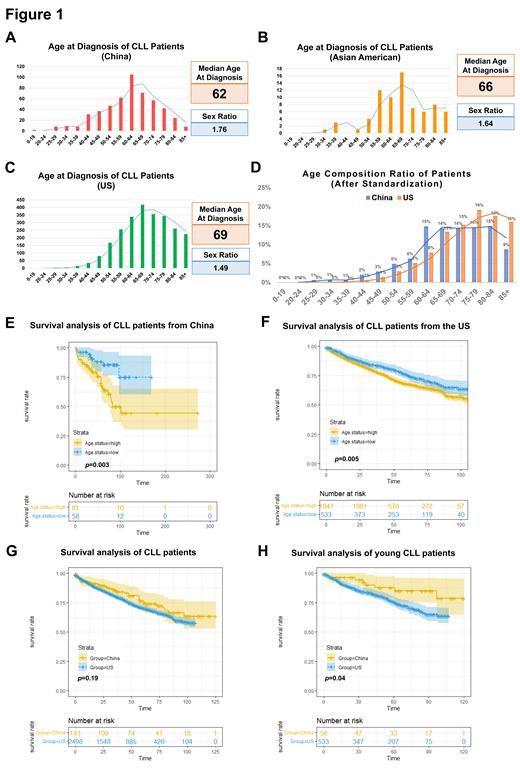Abstract
Introduction
The epidemiological features of chronic lymphocytic leukemia (CLL) are different in the United States (US) and China. In addition to variant incidence rates, the median age at diagnosis of CLL patients in the Shandong Provincial Hospital CLL (SPHCLL) database is younger than the Surveillance, Epidemiology, and End Results (SEER) database. However, investigations on the association between age at onset and other clinical characteristics of Chinese patients with CLL remain unclear. Hence, the aim of this study was to explore the clinical-pathological parameters and prognosis of Chinese patients with CLL which were divided into the young (<60 years) group and the elderly (≥60 years) group.
Methods
The clinical data of 510 Chinese CLL patients diagnosed between October 2010 and June 2020 were obtained from the SPHCLL database. Meanwhile, the survival data of 2580 CLL patients diagnosed between 2010 and 2018 were obtained with SEER*Stat 8.1.5 from the SEER database. Patients <60 years were divided into the young group and patients ≥60 years were divided into the elderly group. Clinical-pathological parameters were accessed from the hospital-based laboratory service within 24 hours after the first admission. SPSS 23 and R 4.0.5 were used in analyzing the data. Moreover, Kaplan-Meier survival analysis, univariate Cox regression analysis and multivariate Cox regression analysis were performed to evaluate the prognosis of CLL patients. Comparisons of clinical characteristics between young and elderly CLL patients were made using t test and Chi-square test. p < 0.05 was defined as the borderline of statistical significance.
Results
The median age at diagnosis of Chinese patients, Asian American patients and patients of predominately European descent were 62, 66 and 69 years respectively (Figure 1A-C). After adjustments according to the population age distribution of China and the US, patients in the Chinese SPHCLL database presented earlier age at onset than the SEER database (Figure 1D).
To further explore the clinical characteristics of young and elderly Chinese CLL patients, the general clinical data and laboratory parameters were analyzed among young and elderly CLL patients. Compared with elderly CLL patients, young CLL patients showed a higher percentage of cytogenetic aberrations detected by fluorescence in situ hybridization (p< 0.05). The proportion of patients with combined diseases was higher in elderly patients than young patients, especially coronary heart disease and hypertension (p< 0.05). The levels of prealbumin, albumin, Apolipoprotein A and Lp (a) were higher in young CLL patients, while the levels of β2-macroglobulin were lower in young CLL patients (p< 0.05). Moreover, the proportion of young CLL patients who accepted CHOP/RCHOP treatment was significantly higher.
The overall survival (OS) of young CLL patients was better than elderly patients in the SPHCLL cohort and the SEER cohort (Figure 1E-F). Intriguingly, young Chinese patients experienced improved OS compared with young patients of predominately European descent (Figure 1G-H). Furthermore, univariate Cox regression analysis presented that apolipoprotein A, hemoglobin, thrombocyte and total cholesterol were positive prognostic factors among young patients, while β2-microglobulin and ADA were negative prognostic factors. In elderly CLL patients, univariate Cox regression analysis showed that albumin, apolipoprotein A, hemoglobin and superoxide dismutasewere positive prognostic factors, while β2-microglobulin, ADA and cystatin were negative prognostic factors. Multivariate Cox regression analysis showed that cystatin was an independent prognostic factor in elderly CLL patients.
Conclusion
In conclusion, Chinese CLL patients are characterized by earlier age at onset than patients of predominately European descent. The investigation presented a comprehensive profile of young and elderly CLL patients from China, contributing to the optimal management strategies of CLL patients in variant age groups.
No relevant conflicts of interest to declare.


This feature is available to Subscribers Only
Sign In or Create an Account Close Modal